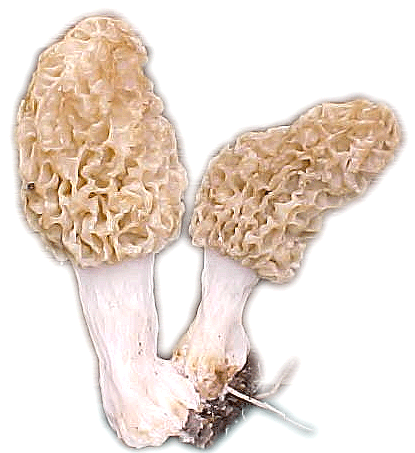|
 Morel Morchella,
Black Morel, White Morel, Yellow Morel, Grey Morel, Sponge
Mushroom, Morille (French), Morchel (German),
Amigasatake (Japanese). Morel Morchella,
Black Morel, White Morel, Yellow Morel, Grey Morel, Sponge
Mushroom, Morille (French), Morchel (German),
Amigasatake (Japanese).
With a sponge-like texture this is among
the best known mushrooms: a very tasty prized wild fungus that appears in
the spring. The morel is considered to be the epitome of wild edible
mushrooms. Commercial production has never been successful on the morel
leaving the morel as one of the top three sought after wild mushrooms
along with the Cèpe
and Chanterelle. It is sold
in fresh, dried and canned form. Morels favor limestone areas and occur
where the soil has been disturbed. They produce in mass after forest
fires.
Storage Young specimens will keep
for 10 days at 34 degrees F.
|
Jan |
Feb |
March |
April |
May |
June |
July |
Aug |
Sept |
Oct |
Nov |
Dec |
|
Morel |
|
|
|
|
|
|
|
|
|
|
[ American Matsutake ] [ Black Truffle ] [ Black Trumpet ] [ Blewit ] [ Blue Foot ] [ Boletus ] [ Buna shimeji ] [ Cauliflower ] [ Cepe ] [ Chanterelle ] [ Charbonnier ] [ Chicken of the Woods ] [ Cinnimon Cap ] [ Coral Mushroom ] [ Cottonwood ] [ Crimini ] [ Cultivated Mushrooms ] [ Enoki ] [ Fairy Ring ] [ Golden Trumpet ] [ Hedgehog ] [ Hen of the Woods ] [ Honey ] [ Huitlacoche ] [ Lactaire ] [ Lobster ] [ Morel ] [ Nameko ] [ Oyster ] [ Parasols ] [ Pig Ear ] [ Pompom Blanc ] [ Porcini ] [ Portobello ] [ Puff Ball ] [ Royal King ] [ Shaggy Lepiota ] [ Shaggy Mane ] [ Shiitake ] [ Straw Mushroom ] [ White Truffle ] [ Woodear ] [ Yellow Oyster ]
         |




 Morel Morchella,
Black Morel, White Morel, Yellow Morel, Grey Morel, Sponge
Mushroom, Morille (French), Morchel (German),
Amigasatake (Japanese).
Morel Morchella,
Black Morel, White Morel, Yellow Morel, Grey Morel, Sponge
Mushroom, Morille (French), Morchel (German),
Amigasatake (Japanese).